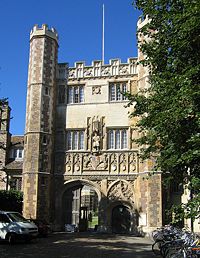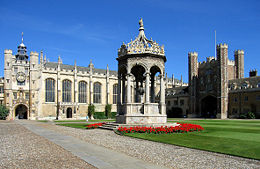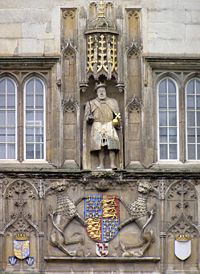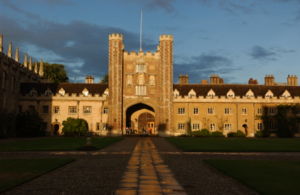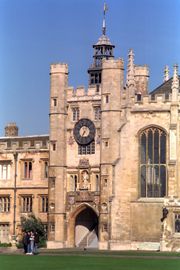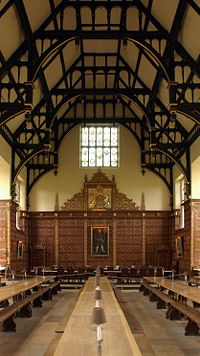Trinity College, Cambridge
2008/9 Schools Wikipedia Selection. Related subjects: Education
| Colleges of the University of Cambridge Trinity College |
||||||||||||
|---|---|---|---|---|---|---|---|---|---|---|---|---|
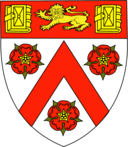 |
||||||||||||
|
|
||||||||||||
| College name | The Master, Fellows and Scholars of the College of the Holy and Undivided Trinity in the Town and University of Cambridge | |||||||||||
| Motto | Virtus Vera Nobilitas (Latin: Virtue is true nobility) |
|||||||||||
| Named after | The Holy Trinity | |||||||||||
| Established | 1546 | |||||||||||
| Previously named | King’s Hall and Michaelhouse (until merged in 1546) | |||||||||||
| Location | Trinity Street | |||||||||||
| Admittance | Men and women | |||||||||||
| Master | The Lord Rees of Ludlow | |||||||||||
| Undergraduates | 663 | |||||||||||
| Graduates | 430 | |||||||||||
| Sister college | Christ Church, Oxford | |||||||||||
| Official website | ||||||||||||
| Boat Club website | ||||||||||||
Trinity College is a constituent college of the University of Cambridge in Cambridge, England. Trinity has more students than any other college in Cambridge or Oxford, with around 660 undergraduates, 430 graduates, and over 160 Fellows. It is also the wealthiest Oxbridge college with an estimated financial endowment of approximately £700 million (as of 2005), in addition to which Trinity's land is insured for approx. £266.5 million (this does not include all fixed assets). Trinity considers itself to be "a world-leading academic institution with an outstanding record of education, learning and research", and on a per-student basis, is one of the best-endowed educational institutions in the world - amounting to approximately £640,000 per student in 2005, more than ten times the average of £63,000 at all the other colleges.
Like its sister college, Christ Church, Oxford, it has traditionally been considered the most aristocratic of the Cambridge colleges - it has generally been the academic institution of choice of the Royal Family (King Edward VII, King George VI, Prince Henry of Gloucester, Prince William of Gloucester and Edinburgh and Prince Charles were all undergraduates). The Push Guide to Which University (2005) called it "arguably the grandest Cambridge college" and it has been called "the most magnificent collegiate institution in England.". However, the proportion of state school to public school pupils is now roughly equal, in line with most other Cambridge colleges. Nevertheless, in 2005 it had the lowest state school intake (42%) of any college, though this figure fluctuates from year to year. It first admitted women in 1977.
The college is a major landowner, including holdings in the Port of Felixstowe, and the Cambridge Science Park. Trinity has a very strong academic tradition, with members having won thirty-one Nobel Prizes (more than most countries, with the exception of the United States, Germany, and France, and not counting the United Kingdom), five Fields Medals (mathematics), one Abel Prize (mathematics) and two Templeton Prizes (religion). Trinity has many distinguished alumni – the most notable being Sir Isaac Newton. It has also educated six British Prime Ministers, more than any other Cambridge college.
Trinity has many college societies, and its rowing club is the First and Third Trinity Boat Club. Trinity's May Ball, named after the Boat Club, is the largest and most traditional of Cambridge's May Balls.
The first formalized version of the rules of football, known as the Cambridge Rules, was drawn up by Cambridge student representatives of leading public schools at Trinity College in 1848 .
History
The college was founded by Henry VIII in 1546, from the merger of two existing colleges: Michaelhouse (founded by Hervey de Stanton in 1324), and King’s Hall (established by Edward II in 1317 and refounded by Edward III in 1337).
At the time, Henry had been wiping out and seizing church lands from abbeys and monasteries. The universities of Oxford and Cambridge, being both religious institutions and quite rich, expected to be next in line. The king duly passed an Act of Parliament that allowed him to suppress (and confiscate the property of) any college he wished.
The universities used their contacts to plead with his sixth wife, Catherine Parr. The queen persuaded her husband not to close them down, but to create a new college. The king did not want to use royal funds, so he instead combined two colleges ( King’s Hall and Michaelhouse) and seven hostels (Physwick (formerly part of Gonville and Caius College, Cambridge), Gregory’s, Ovyng’s, Catherine’s, Garratt, Margaret’s, and Tyler’s) to form Trinity. This, combined with lands confiscated from the Church, caused Trinity to be the richest and biggest college.
Most of the college’s major buildings date from the 16th and 17th centuries. Thomas Nevile, who became Master of Trinity in 1593, rebuilt and re-designed much of the college. This work included the enlargement and completion of Great Court, and the construction of Nevile’s Court between Great Court and the river Cam. Nevile’s Court was completed in the late 17th century when the Wren Library, designed by Sir Christopher Wren, was built.
In the 20th century, Trinity College and King’s College were for decades the main recruiting grounds for the Cambridge Apostles, an elite, intellectual secret society.
The full name of the college is The Master, Fellows and Scholars of the College of the Holy and Undivided Trinity in the Town and University of Cambridge.
Buildings and Grounds
- King’s Hostel (1377-1416, various architects)
- Located to the north of Great Court, behind the Clock Tower, this is (along with the King’s Gate), the sole remaining building from King’s Hall.
- Great Gate
- The Great Gate is the main entrance to the college, leading to the Great Court. A statue of the college founder, Henry VIII, stands in a niche above the doorway. In his hand he holds a table leg instead of the original sword and myths abound as to how the switch was carried out and by whom. In 1704, the University’s first astronomical observatory was built on top of the gatehouse. Beneath the founder's statue are the coats of arms of Edward III, the founder of King's Hall, and his five sons of who survived to maturity, as well as William of Hatfield, whose shield is blank as he died as an infant, before being granted arms.
- Great Court (principally 1599-1608, various architects)
- The brainchild of Thomas Nevile, who demolished several existing buildings on this site, including almost the entirety of the former college of Michaelhouse. The sole remaining building of Michaelhouse was replaced by the current Kitchens (designed by James Essex) in 1770-1775. See 360° panorama of Great Court from the BBC.
- Nevile’s Court (1614, unknown architect)
- Located between Great Court and the river, this court was created by a bequest by the college’s master, Thomas Nevile, originally ⅔ of its current length and without the Wren Library. The appearance of the upper floor was remodelled slightly 2 centuries later.
- Bishop’s Hostel (1671, Robert Minchin)
- A detached building to the south-west of Great Court, and named after John Hacket, Bishop of Lichfield and Coventry. Additional buildings were built in 1878 by Arthur Blomfield.
- Wren Library (1676-1695, Christopher Wren)
- Located at the west end of Nevile’s Court, the Wren is one of Cambridge’s most famous and well-endowed libraries. Among its notable possessions are two of Shakespeare’s First Folios, a 14th-century manuscript of The Vision of Piers Plowman, and letters written by Sir Isaac Newton. Below the building are the pleasant Wren Library Cloisters, where students may enjoy a fine view of the Great Hall in front of them, and the river and Backs directly behind.
- New Court (or King’s Court; 1825, William Wilkins)
- Located to the south of Nevile’s Court, and built in Tudor-Gothic style, this court is notable for the large tree in the centre. A myth is sometimes circulated that this was the tree from which the apple dropped onto Isaac Newton; in fact Newton was at Grantchester when he deduced his theory of gravity. Many other “New Courts” in the colleges were built at this time to accommodate the new influx of students.
- Whewell’s Courts (1860 & 1868, Anthony Salvin)
- Located across the street from Great Court, these two courts were entirely paid for by William Whewell, the then master of the college. The north range was later remodelled by W.D. Caroe. Note: Whewell is pronounced “Hugh-well”.
- Angel Court (1957-1959, H. C. Husband)
- Located between Great Court and Trinity Street.
- Wolfson Building (1968-1972, Architects Co-Partnership)
- Located to the south of Whewell’s Court, on top of a podium above shops, this building resembles a brick-clad ziggurat, and is used exclusively for first-year accommodation. Having been renovated during the academic year 2005-06, it is once again in use.
- Blue Boar Court (1989, MacCormac Jamieson Prichard and Wright)
- Located to the south of the Wolfson Building, on top of podium a floor up from ground level, and including the upper floors of several surrounding Georgian buildings on Trinity, Green and Sidney Street.
- Burrell's Field (1995, MacCormac Jamieson Prichard )
- Located on a site to the west of the main College buildings, opposite the Cambridge University Library.
There are also College rooms above shops in Bridge Street and Jesus Lane, behind Whewell’s Court and graduate accommodation in Portugal Street and other roads around Cambridge.
- Fellows’ Garden
- Located on the west side of Queens Road, opposite the drive that leads to the Backs.
- Fellows’ Bowling Green
- Located behind the Master’s Lodge
- Master’s Garden
- Located behind the Master’s Lodge.
- Old Fields
- Located on the western side of Grange Road, next to Burrell’s Field, with sports (badminton, etc) facilities.
- New Fields
Traditions
The Great Court Run
The Great Court Run is an attempt to run round the perimeter of Great Court (approximately m367, in the 43 seconds during the clock striking twelve. Students traditionally attempt to complete the circuit on the day of the Matriculation Dinner. It is a rather difficult challenge: one needs to be a fine sprinter to achieve it, but it is by no means necessary to be of Olympic standard, despite assertions made in the press
It is widely believed that Sebastian Coe successfully completed the run when he beat Steve Cram in a charity race in October 1988. Sebastian Coe's time on 29 October 1988 was reported by Norris McWhirter to have been 45.52 seconds, but it was actually 46.0 seconds (confirmed by the video tape), while Cram's was 46.3 seconds. The clock on that day took 44.4 seconds (i.e. a "long" time, probably two days after the last winding) and the video film confirms that Coe was some 12 metres short of his finish line when the fateful final stroke occurred. The television commentators were more than a little disingenuous in suggesting that the dying sounds of the bell could be included in the striking time, thereby allowing Coe's run to be claimed as successful.
One reason Olympic runners Cram and Coe found the challenge so tough is that they started at the middle of one side of the Court, thereby having to negotiate four right-angle turns. In the days when students started at the corner, only three turns were needed.
Until the mid 1990s, the run was traditionally attempted by first year students, at midnight following their Matriculation Dinner. Following a number of accidents to drunk undergraduates running on slippery cobbles, the college now organises a more formal Great Court Run, at 12 noon: the challenge is only open to freshers, many of whom compete in fancy dress.
Open-Air Concerts
One Sunday each June (the exact date depends on the university term), the College Choir perform a short concert immediately after the clock strikes noon. Known as Singing from the Towers, half of the choir sings from the top of Great Gate, while the other half sings from the top of the Clock Tower (approximately 60 metres away), giving a strong antiphonal effect. Midway through the concert, a brass band performs from the top of Queen’s Tower. Later that same day, the College Choir gives a second open-air concert, known as Singing on the River, where they perform madrigals (and arrangements of popular songs) from a raft of punts on the river. As a 'tradition', however, this latter event dates back only to the mid-1980s, when the College Choir first acquired female members. In the years immediately before this an annual concert on the river was given by the University Chamber Choir.
Mallard
Another tradition relates to a duck (known as the Mallard), which resides in the rafters of the Great Hall. Students occasionally move the duck from one rafter to another (without permission from the college), having been photographed with the mallard as proof. This is considered difficult and access to the Hall outside meal-times is prohibited. In addition, the rafters are high so it has not been attempted for several years. During the Easter term of 2005, several pigeons entered the Hall through the windows in the pinnacle, and one knocked the Mallard off its rafter. It was found intact on the floor, and revealed to not be made out of wood as previously believed. It is currently held by the College catering staff. It is unknown whether it will be reinstated.
Bicycles and chair legs
For many years it was the custom for students to place a bicycle high in branches of the tree in the centre of New Court. Usually invisible except in winter, when the leaves had fallen, such bicycles tended to remain for several years before being removed by the authorities. The students then inserted another bicycle. Similarly, the sceptre held by the statue of Henry VIII mounted above the medieval Great Gate was replaced with a chair leg as a prank many years ago. It has remained there to this day: when in the 1980s students exchanged the chair leg for a bicycle pump, the College replaced the chair leg.
College Rivalry
The college remains a great rival of St John’s who are their main competitor in sports and academia (John’s is situated next to Trinity). This has given rise to a number of anecdotes and myths. It is often cited as the reason why the courts of Trinity generally have no J staircases, despite including other letters in alphabetical order. Burrell’s Field and Whewell's Court have a J staircase but New, Great and Nevile’s Courts skip the letter. The reason is more one of tradition and the absence of the letter J in the Roman alphabet. There are also two small muzzle-loading cannons on the bowling green pointing in the direction of John’s, though this orientation may be coincidental.
Minor Traditions Trinity College undergraduate gowns are dark blue, as opposed to the black favoured by most other Cambridge colleges. Unlike any other Cambridge college the porters always wear black bowler hats. This tradition is shared with Trinity's sister college Christ Church, Oxford. As with many other Cambridge colleges, the grassed courtyards are generally out of bounds for everyone except the Fellows. Only one of two meadows on “the Backs” (riverside area behind the college) are accessible to students. Other lawns are accessible to graduates in formal gowns.
Scholarships and Prizes
The Scholars, together with the Master and Fellows, make up the Foundation of the College.
In order of seniority:
Research Scholars receive funding for graduate studies. Typically one must graduate in the top ten percent of one's class and continue for graduate study at Trinity. They are given first preference in the assignment of college rooms and number approximately 25.
The Senior Scholars consist of those who attain a degree with First Class honours or higher in any year after the first of an undergraduate tripos, but also, those who obtain an extremely good First in their first year. For example in the Mathematics tripos a result in the top three would be required to gain this position early. The college pays them a stipend of £250 a year and also allows them to choose rooms directly following the research scholars. There are around 40 senior scholars at any one time.
The Junior Scholars are precisely those who are not senior scholars but still obtained a First in their first year. Their stipend is £175 a year. They are given preference in the room ballot over 2nd years who are not scholars.
These scholarships are tenable for the academic year following that in which the result was achieved. If a scholarship is awarded but the student does not continue at Trinity then only a quarter of the stipend is given. However all students who achieve a First are awarded an additional £200 prize upon announcement of the results.
All final year undergraduates who achieve first-class honours in their final exams are offered full financial support for proceeding with a Master’s degree at Cambridge (this funding is also sometimes available for good students who achieved high second-class honours). Other support is available for PhD degrees. The College also offers a number of other bursaries and studentships open to external applicants. The highly-regarded right to walk on the grass in the college courts is exclusive to Fellows of the college and their guests. Scholars do however have the right to walk on Scholar’s Lawn, but only in full academic dress.
Trinity in Camberwell
Trinity College has a long-standing relationship with the Parish of St George’s, Camberwell, in South London. Students from the College have helped to run holiday schemes for children from the parish since 1966. The relationship was formalized in 1979 with the establishment of Trinity in Camberwell as a registered charity ( Charity Commission no. 279447) which exists ‘to provide, promote, assist and encourage the advancement of education and relief of need and other charitable objects for the benefit of the community in the Parish of St George’s, Camberwell, and the neighbourhood thereof.’
Legends
Many apocryphal stories have been told about the college’s wealth. Trinity is sometimes suggested to be the second, third or fourth wealthiest landowner in the UK (or in England) - after the Crown Estate, the National Trust and the Church of England. (A variant of this legend is repeated in the Tom Sharpe novel Porterhouse Blue.) This story is frequently repeated by tour guides. In 2005, Trinity's annual rental income from its properties was reported to be in excess of £20 million. In comparison, the National Trust's rental income in 2005-6 was around £78 million. (See Trinity College's riches)
A second legend is that it is possible to walk from Cambridge to Oxford on land solely owned by Trinity. Several varieties of this legend exist - others refer to the combined land of Trinity College, Cambridge and Trinity College, Oxford, or of Trinity College, Cambridge and Christ Church, Oxford. All are most certainly false.
Trinity has a tradition of maintaining extensive wine cellars beneath Great Court and Whewell's Court, the size and value of which is the subject of rumour .
Trinity also lays claim to the invention of an English, less sweet, version of crème brûlée sometimes known as “Trinity burnt cream” , although the college catering department refers to it as "Trinity Creme Brulee."
Notable alumni
Trinity Nobel Prize winners
| Name | Field | Year |
|---|---|---|
| Lord Rayleigh | Physics | 1904 |
| J. J. Thomson | Physics | 1906 |
| Lord Rutherford | Chemistry | 1908 |
| William Bragg | Physics | 1915 |
| Lawrence Bragg | Physics | 1915 |
| Charles Glover Barkla | Physics | 1917 |
| Niels Bohr | Physics | 1922 |
| Francis Aston | Chemistry | 1922 |
| Archibald V. Hill | Physiology or Medicine | 1922 |
| Sir Austen Chamberlain | Peace | 1925 |
| Owen Willans Richardson | Physics | 1928 |
| Sir Frederick Hopkins | Physiology or Medicine | 1929 |
| Edgar Douglas Adrian | Physiology or Medicine | 1932 |
| Sir Henry Dale | Physiology or Medicine | 1936 |
| George Paget Thomson | Physics | 1937 |
| Bertrand Russell | Literature | 1950 |
| Ernest Walton | Physics | 1951 |
| Richard Synge | Chemistry | 1952 |
| John Kendrew | Chemistry | 1962 |
| Alan Lloyd Hodgkin | Physiology or Medicine | 1963 |
| Sir Andrew Huxley | Physiology or Medicine | 1963 |
| Brian David Josephson | Physics | 1973 |
| Martin Ryle | Physics | 1974 |
| James Meade | Economic Sciences | 1977 |
| Pyotr Kapitsa | Physics | 1978 |
| Walter Gilbert | Chemistry | 1980 |
| Aaron Klug | Chemistry | 1982 |
| Subrahmanyan Chandrasekhar | Physics | 1983 |
| James Mirrlees | Economic Sciences | 1996 |
| John Pople | Chemistry | 1998 |
| Amartya Sen | Economic Sciences | 1998 |
Trinity Prime Ministers
| Name | Party | Year |
|---|---|---|
| Spencer Perceval | Tory | 1809-1812 |
| Earl Grey | Whig | 1830-1834 |
| Viscount Melbourne | Whig | 1834-1841 |
| Arthur Balfour | Conservative | 1902-1905 |
| Sir Henry Campbell-Bannerman | Liberal | 1905-1908 |
| Stanley Baldwin | Conservative | 1923-1924 1924-1929 1935-1937 |
Other Trinity politicians include Robert Devereux, 2nd Earl of Essex, courtier of Elizabeth I; William Waddington, Prime Minister of France; Jawaharlal Nehru, Prime Minister of India, Erskine Childers, President of the Irish Republic; Rajiv Gandhi, Prime Minister of India; Lee Hsien Loong, Prime Minister of Singapore and Willie Whitelaw, Margaret Thatcher's Home Secretary.
College Officials
List of Masters
The head of Trinity College is the Master. The first Master was John Redman who was appointed in 1546. The role is a Royal appointment and in the past was sometimes made by the Monarch as a favour to an important person. Nowadays the Fellows of the College, and to a lesser extent the Government, choose the new Master and the Royal role is only nominal. In modern times the Master has customarily been of the highest academic distinction. The last three Masters have all been fellows of the college. A complete list of the Masters of Trinity is below.
| Name | Start of service | End of Service |
|---|---|---|
| John Redman | 1546 | 1551 |
| William Bill | 1551 | 1553 |
| John Christopherson | 1553 | 1558 |
| William Bill | 1558 | 1561 |
| Robert Beaumont | 1561 | 1567 |
| John Whitgift | 1567 | 1577 |
| John Still | 1577 | 1593 |
| Thomas Nevile | 1593 | 1615 |
| John Richardson | 1615 | 1625 |
| Leonard Mawe | 1625 | 1629 |
| Samuel Brooke | 1629 | 1631 |
| Thomas Comber | 1631 | 1645 |
| Thomas Hill | 1645 | 1653 |
| John Arrowsmith | 1653 | 1659 |
| John Wilkins | 1659 | 1660 |
| Henry Ferne | 1660 | 1662 |
| John Pearson | 1662 | 1672 |
| Isaac Barrow | 1672 | 1677 |
| John North | 1677 | 1683 |
| John Montagu | 1683 | 1699 |
| Richard Bentley | 1700 | 1742 |
| Robert Smith | 1742 | 1768 |
| John Hinchcliffe | 1768 | 1789 |
| Thomas Postlethwaite | 1789 | 1798 |
| William Lort Mansel | 1798 | 1820 |
| Christopher Wordsworth | 1820 | 1841 |
| William Whewell | 1841 | 1866 |
| William Hepworth Thompson | 1866 | 1886 |
| Henry Montagu Butler | 1886 | 1918 |
| Sir Joseph Thomson | 1918 | 1940 |
| George Macaulay Trevelyan | 1940 | 1951 |
| The Lord Adrian | 1951 | 1965 |
| The Lord Butler of Saffron Walden | 1965 | 1978 |
| Sir Alan Hodgkin | 1978 | 1984 |
| Sir Andrew Huxley | 1984 | 1990 |
| Sir Michael Atiyah | 1990 | 1997 |
| Amartya Sen | 1998 | 2004 |
| The Lord Rees of Ludlow | 2004 |
List of Deans of Chapel
- Harry Williams -1969
- John Robinson 1969-1983
- John Bowker 1984-1991
- Arnold Browne 1991-2006
- Michael Banner 2006-present

